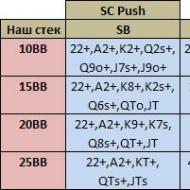
Economically active population of Russia: characteristics, numbers. Economic activity and employment statistics
The most important component of socio-economic statistics is labor statistics. Its indicators characterize the number, composition, regional distribution and use labor resources; use of working time; level and dynamics of labor productivity; labor costs, wages, conditions, labor protection and safety and other phenomena and processes. Issues of labor statistics are discussed in full in the sectoral statistics course. This topic examines indicators of the number of labor resources and working hours.
The main objectives of labor market statistics are:
- collection of information on the number of employed and unemployed as two components of the labor force;
- study of the status and trends in Russian market labor through indicators of employment and unemployment;
- studying the composition of the employed and unemployed according to various characteristics (gender, age, industries and sectors of the economy, by region of the country and other characteristics) in order to regulate the labor market, develop programs to increase the level of employment, employ the unemployed, their professional retraining, etc.
Employed and unemployed
The entire population of the country can be divided into two groups: economically active and economically inactive. active population.
- this is the part of the population that offers its labor for the production of goods and services.
The economically active population (also called the labor force) includes two categories - employed and unemployed.
Employed persons include persons of both sexes aged 16 years and older, as well as persons of younger ages who, during the period under review:
- performed hired work for remuneration, money or paid in kind, as well as other income-generating work;
- temporarily absent from work due to: illness or injury; days off; annual leave; various types of leaves, both with and without pay, time off; leaves at the initiative of the administration; strikes and other reasons;
- performed work without pay in the family business.
When classifying or not classifying a person as employed, the criterion of one hour is used. In Russia, when surveying employment, the number of employed includes persons who worked one hour or more in the surveyed week. The use of this criterion is due to the fact that it is necessary to cover all types of employment that may exist in the country - from permanent to short-term, casual and other types of irregular employment.
Unemployed persons include persons aged 16 years and older who, during the period under review:
- did not have a job (or income-generating occupation);
- were looking for a job;
- were ready to get to work.
This definition is consistent with the methodology of the International Labor Organization (ILO). When classifying a person as unemployed, all three criteria listed above must be taken into account.
is the population that is not part of the labor force. This includes: pupils and students; pensioners; persons receiving disability pensions; persons involved in maintaining household; persons who have stopped looking for work, having exhausted all possibilities for obtaining it, but who are able and ready to work; other persons who do not need to work regardless of their source of income.
— ensure the supply of labor in the labor market for the production of goods, performance of work and provision of services. That is, they want to work, but at the same time they can both work and look for work. In accordance with this, the economically active population is divided into two categories: the number of people employed in sectors of the economy and the number of unemployed.
The economically active population is part of the labor force. The number of economically active population changes in individuals in relation to a certain period of time.
Number of employees in economic sectors is an indicator characterizing the demand for labor in the labor market. The higher the demand for labor, the higher the employment rate in the economy. Every economy strives for population indicators.
Number of unemployed is the excess of supply over demand for labor in the labor market. Typically, supply exceeds demand for labor, which objectively determines the availability. This does not exclude the opposite situation in certain parts of the labor market (regional, by type of activity).
Economically inactive population
Economically inactive population- these are persons capable of working (they are included in the labor force), but they cannot be classified as either.
Economically inactive population is a population that is not part of work force. This includes: pupils and students; pensioners; persons receiving disability pensions; persons engaged in housekeeping; persons who have stopped looking for work, having exhausted all possibilities for obtaining it, but who are able and ready to work; other persons who do not need to work regardless of their source of income.
Categories discussed above economic activity The population does not assume that once a person gets into a group, he remains there forever. The labor market has a highly dynamic nature, so one should consider not only the size of each group for a certain period of time, but also the movement (flows) of people between various groups. The diagram below illustrates the dynamic model of the labor market.
In a market economy, the possibility of unemployment of the working population is allowed. The reasons for the economic passivity of this part of the population are social status, material security, housekeeping, raising children, or lack of employment prospects. In Russia there are several million people in this category of population. The primary task of statistics is to study employment, that is, the degree of satisfaction of labor supply. The number, composition, territorial distribution and reasons for economic passivity are also studied.
Indicators of population employment and level relate to the main characteristics of the socio-economic situation of the country and the state of the labor market.
In the 90s in the Russian labor market there was a decrease in labor supply, the greatest decline was in 1998. The number of economically active population, despite a slight increase in 1999 and 2000, did not reach the level of 1992 and was 3.3 million people less. There was a significant decrease in the demand for labor. The number of people employed in the economy during this period decreased by 6.4 million people, or 9%. There was a release of labor from state-owned enterprises and organizations due to the decline in production, the redistribution of labor between sectors of the economy, the transition from the public to the private sector, but in general, with a decrease in the number of employees, the number of unemployed systematically increased. The unemployment rate (the share of the unemployed in the economically active population) in 1998 reached 13.2% and until 2000 remained at high level.
Economic activity rate
It is the ratio of the economically active population to the total population.
TaskThe economically active population in Russia in November 2009 amounted to 72.8 million people
- number of employed 65.0 million people
- total population - 144.9 million people.
Find the number of unemployed, the coefficients of economic activity, employment and unemployment.
SolutionThe economically active population includes both employed and unemployed people, therefore,
- Number of unemployed = 72.8 - 65 = 7.8 million people.
- Economic activity rate = (72.8 / 144.9) * 100% = 50%
- Occupancy rate = 65 / 72.8 = 0.9
- = 7,8 / 72,8 = 0,1
- Average annual population: 148,300 thousand people
- Total employment in the economy: 67,100 thousand people.
- Number of unemployed: 6410 thousand people.
Find: the number of economically active population (EAP), the coefficient of economic activity of the population, the employment rate and the unemployment rate of the population.
Solution- EAN = 67100 + 6410 = 73510 thousand people.
- Coefficient EAN = 73510 / 148300 = 0.5
- Occupancy factor = 67100 / 73510 = 0.91
- Unemployment rate = 6410 / 73510 = 0.09
The number of employed and unemployed as of the dates was:
Find: the average number of employed, unemployed, economically active population for the year, employment and unemployment rates for this period.
Solution1. We calculate the average number of employed and unemployed using the simple average chronological formula.
2. The economically active population is the sum of the employed and the unemployed.
- EAN = 718+73.25 = 791.25
3. To employment = 718 / 791.25 = 0.91
4. To unemployment = 73.25 / 791.25 = 0.09
Economically active population
Based on materials from sample surveys of the population on employment problems: 1992, 1995. - at the end of October; 2000-2007 - at the end of November. Since 2006 - including data for the Chechen Republic.
Thousands of people |
|||||||||
| Total | 75060 | 70740 | 72332 | 72421 | 72835 | 72909 | 73811 | 74156 | 75046 |
| including: | |||||||||
| employed in the economy | 71171 | 64055 | 65273 | 66266 | 67152 | 67134 | 68603 | 69157 | 70813 |
| unemployed | 3889 | 6684 | 7059 | 6155 | 5683 | 5775 | 5208 | 4999 | 4232 |
| Men | 39197 | 37338 | 37499 | 36997 | 37206 | 37079 | 37511 | 37627 | 37967 |
| including: | |||||||||
| employed in the economy | 37161 | 33726 | 33754 | 33709 | 34199 | 34177 | 34710 | 34996 | 35702 |
| unemployed | 2036 | 3613 | 3745 | 3288 | 3007 | 2902 | 2801 | 2631 | 2264 |
| Women | 35863 | 33401 | 34833 | 35423 | 35629 | 35831 | 36300 | 36529 | 37079 |
| including: | |||||||||
| employed in the economy | 34010 | 30330 | 31519 | 32557 | 32953 | 32958 | 33893 | 34161 | 35111 |
| unemployed | 1853 | 3072 | 3314 | 2866 | 2676 | 2873 | 2407 | 2368 | 1968 |
As a percentage of the total |
|||||||||
| Economically active population - Total |
100 | 100 | 100 | 100 | 100 | 100 | 100 | 100 | 100 |
| including: | |||||||||
| employed in the economy | 94,8 | 90,5 | 90,2 | 91,5 | 92,2 | 92,1 | 92,9 | 93,3 | 94,4 |
| unemployed | 5,2 | 9,5 | 9,8 | 8,5 | 7,8 | 7,9 | 7,1 | 6,7 | 5,6 |
| Men | 100 | 100 | 100 | 100 | 100 | 100 | 100 | 100 | 100 |
| including: | |||||||||
| employed in the economy | 94,8 | 90,3 | 89,8 | 91,1 | 91,9 | 92,2 | 92,5 | 93,0 | 94,0 |
| unemployed | 5,2 | 9,7 | 10,2 | 8,9 | 8,1 | 7,8 | 7,5 | 7,0 | 6,0 |
| Women | 100 | 100 | 100 | 100 | 100 | 100 | 100 | 100 | 100 |
| including: | |||||||||
| employed in the economy | 94,8 | 90,8 | 90,5 | 91,9 | 92,5 | 92,0 | 93,4 | 93,5 | 94,7 |
| unemployed | 5,2 | 9,2 | 9,5 | 8,1 | 7,5 | 8,0 | 6,6 | 6,5 | 5,3 |
The population of a country that has or desires and could potentially have an independent source of livelihood. According to the methodology of the International Labor Organization, this category includes people aged 10 to 72 years:
- employed (entrepreneurs and hired workers)
The peculiarity of this indicator is that it depends on a person’s self-determination. Thus, some groups of citizens can be classified as the economically active population only partially (for example, full-time university students or pensioners are not fully classified in this category, but depending on whether the citizen has a need for work, is ready to start work and is looking for whether they work).
Depending on the level of development of the country, the lower age threshold for which data is collected and published varies. Thus, in African countries, due to the high prevalence of child labor, children are included in the economically active population from the age of 10 years. It is conventionally believed that in developed countries there is no employment from the age of 10 years to the lower limit of the age threshold, for example, in Russia the lower limit of the age at which a person is included in the economically active population is 15 years old, in the USA - from 16 years old. In Russia, in accordance with ILO requirements, the economically active population is recorded as part of a population survey on employment problems, which is conducted once a quarter. Rosstat publishes the statistical collection “Labor and Employment in Russia” once every two years, and also periodically publishes the statistical collection “Economically Active Population”.
Notes
see also
Links
- The size of the economically active population of Russia. ( pivot table on the portal of the Federal State Statistics Service)
- Great Soviet Encyclopedia: “Economically active population” // V. V. Pokshishevsky
Wikimedia Foundation. 2010.
- Württembergsky, Alexander
- Akatevo (Kolomensky district, Moscow region)
See what “Economically active population” is in other dictionaries:
ECONOMICALLY ACTIVE POPULATION Big Encyclopedic Dictionary
Economically active population- part of the population engaged in socially useful activities that generate income. UN statistics also include the unemployed in the economically active population. The share of the economically active population is on average St. 45% in economic... ... Political science. Dictionary.
ECONOMICALLY ACTIVE POPULATION- ECONOMICALLY ACTIVE population, part of the population engaged in socially useful activities that generate income. UN statistics also include the unemployed in the economically active population. In international statistics, the share of men’s economic... ... Modern encyclopedia
Economically active population- ECONOMICALLY ACTIVE POPULATION, part of the population engaged in socially useful activities that generate income. UN statistics also include the unemployed in the economically active population. In international statistics, the share of men’s economic... ... Illustrated Encyclopedic Dictionary
ECONOMICALLY ACTIVE POPULATION- ECONOMICALLY ACTIVE POPULATION, part of the population engaged in socially useful activities that generate income for them. The concept of E. a. n. plays an important role in a comprehensive analysis of the role of human resources in economics. development. Share of E. a. n. depends on the share... ... Demographic Encyclopedic Dictionary Economic dictionary
economically active population- — EN active population The number of people available and eligible for employment within a given enterprise, region or nation. (Source: ODE)… … Technical Translator's Guide
ECONOMICALLY ACTIVE POPULATION, part of the population engaged in socially useful activities that generate income for them. The concept of “economically active population” plays an important role in a comprehensive analysis of the role of human resources in economic development. The share of the economically active population depends on the share of the working age population in the entire population, as well as on the degree of employment of individual age groups.
The level of economic activity of the population in developing countries is lower than in economically developed ones. The differences would be greater if children and women were not included in the economically active population in developing countries rural areas, taking part in agricultural work to a very small extent.
The term “economically active population” is used in the international standard system of concepts, but in capitalist countries it is not strictly statistically defined, which makes it difficult to compare data. In accordance with UN recommendations, the economically active population includes not only actually working people, but also the unemployed looking for paid work, and therefore the working economically active population is distinguished. In foreign publications, the concepts of “economically active population” and “labor force” are used as synonyms. Internationally, data on the male economically active population is the most statistically comparable. In international statistics, the share of the economically active male population employed in agriculture, serves as an indicator by which countries are divided into industrial (less than 35%), semi-industrial (35-59%) and agricultural (60% or more). Age, sex, professional, educational and qualification structures are important in the analysis of the economically active population.
In the USSR and other socialist countries, the economically active population unites: 1) all working population at working age, with the exception of students taking time away from work, serving in the Armed Forces and employed in the household; 2) persons beyond working age and employed in social production; 3) persons engaged in personal subsidiary agriculture.
Indicators of economic activity of the population, calculated for certain age groups, are called labor activity of the population; they fluctuate significantly across countries and regions depending on the level of social economic development. The activity of the male population remains at a high level during a long period of working life; it decreases somewhat only in the pre-retirement decade; The activity of the female population in most industrialized countries, as a rule, has two maximums, with the second (after the birth of children) being noticeably lower.
The current trend for most regions of the world is to reduce the indicators of economic activity of the population. All this is due to a decrease in the labor activity of the youngest and oldest groups of the population, as well as a fall in the share of the working-age population.
One of the characteristics of the economically active population is the number of dependents (persons older and younger than working age) for every 100 people of the economically active population. IN modern conditions The importance of mobility of the economically active population is increasing. Changes sectoral structure Due to scientific and technological progress, economies with limited labor resources determine the redistribution of the economically active population, which in turn is a significant factor in the development of production and the growth of its efficiency.
The size of the economically active population and indicators of labor activity are important for forecasting and planning economic development, for developing measures for a more complete and rational use of labor resources.
A. A. Tkachenko.
Demographic encyclopedic dictionary. - M.: Soviet encyclopedia. Editor-in-Chief D.I. Valentey. 1985.
Literature:
Urlanis B. Ts., Dynamics and structure of the population of the USSR and the USA, M. 1964; by him, Problems of population dynamics of the USSR, M. 1974; Determinants and consequences of demographic trends. A New Summary of Research Findings on the Interaction of Demographic, Economic and Social Factors, United Nations, Vol. 1, Part 5, New York, 1975, Ch. 9; Sovi A., General population geography, trans. from French, vol. 1 - Economics and population growth, M. 1977.
Classification of the labor force by economic activity and employment status.
Economically active population (labor force) this is the part of the population that offers its labor for production and services.
The part of the economically active population includes employed and unemployed and is measured in relation to the survey period.
The economically active population level is the share of the economically active population in the total population.
The unemployed include persons 16 years of age and older who, during the period under review:
1. did not have a job;
2. were looking for a job;
3. were ready to start work.
When referred to unemployed status it is necessary to collect all these conditions. Unemployment also includes those studying in the direction of service, pupils, students, pensioners and disabled people, if they are looking for work and were ready to start it. The unemployed include persons not engaged in labor activity who are registered with the employment service as having a job.
Unemployment rate This is the proportion of unemployed in the economically active part of the population.
Duration of unemployment This is the period of time during which a person is looking for a job, using any means.
Employed persons include persons of both sexes aged 16 years and older, as well as persons of younger ages who, during the period under review:
1. Performed work for hire and received appropriate remuneration.
2. Temporarily absent from work due to illness or injury, nursing care, annual leave and other reasons.
3. Performing work without pay under the terms of a family contract.
Economically active population ratio determined by dividing the economically active population by the total population.
Employment rate (employment numbers) determined as of the date divided by the number of economically active population.
Economically - not active population This population that is not part of the labor force, including those of younger ages, is set to change the economically active population.
This includes:
1. pupils and students;
2. cadets attending full-time educational institutions;
3. persons who have received old-age pensions and preferential terms;
4. persons who received a pension for the loss of a breadwinner;
5. persons who have received a disability pension;
6. housewives;
7. desperate to find a job;
8. persons who do not need to work.
Employment status is determined for the economically active population (both employed and unemployed).
The economically active population is divided into the following groups:
1. employees;
2. independent persons who provide themselves with work (working on an individual basis, unpaid employees of family enterprises, members of collective enterprises).
Hired workers are divided into two groups:
1. civilian population,
2. military personnel.
Hired workers are divided into subgroups according to the duration of employment:
1. permanent;
2. seasonal;
3. temporary;
4. workers hired to perform casual work, part-time visible employment.
Economics and sociology of labor Special attention pays attention to that part of the population that is the bearer of labor relations in society. This includes those who work, as well as those who would like to work, but for various reasons do not work. The study of resources for labor activity is of great importance when assessing the labor market and the state’s implementation of appropriate demographic policy in order to influence the processes of population reproduction and employment.
The concept of “labor resources” can still be found today. Although, as will be discussed below, the requirements market economy make it necessary to transition our statistics to that accepted in international practice other labor resource accounting recommended by the International Labor Organization (ILO).
Under labor resources understand the part of the population that has the physical development, mental abilities and knowledge necessary to carry out useful activities. Age limits and socio-demographic composition of the labor force are determined by a system of state legislative acts.
To understand the concept of “labor resources” you need to know that, Firstly, depending on age, the entire population can be divided into three groups:
Persons under working age (currently from birth to 15 years inclusive);
Persons of working (working) age (in Russia, women are from 16 to 54 years old, men are from 16 to 59 years old inclusive);
Persons older than working age, i.e. retirement age, upon reaching which an old-age pension is established (in Russia, women from 55, and men from 60 years).
In Russia, the legislative branch has repeatedly considered the need to increase the age threshold: for men - from 60 to 65 years, for women - from 55 to 60 years. However, the difficult economic situation of the working population, low life expectancy, and high mortality in working age are forcing the state to postpone resolving this issue until a more favorable time.
Secondly, depending on their ability to work, they distinguish between those who are able to work and those who are unable to work. In other words, people may be disabled at working age (for example, disabled people of groups I and II of pre-retirement age) and able to work at non-working age (for example, working teenagers and working old-age pensioners).
Based on the above, labor resources include:
1) the population of working age, with the exception of war and labor invalids of groups I and II and non-working persons of working age who receive pensions on preferential terms;
2) working persons of retirement age;
3) working teenagers under 16 years of age.
By Russian legislation Teenagers under 16 years of age are hired upon reaching the age of 15 in exceptional cases. It is also allowed, in order to prepare young people for work, to employ students of secondary schools, vocational schools and secondary specialized educational institutions upon reaching the age of 14 with the consent of one of the parents or a person replacing him, provided that they are provided with light work that does not cause harm to health and does not interfere with the learning process.
Since mid-1993, the statistics of the Russian Federation has made a transition to the population classification system recommended by international conferences of labor statisticians and the ILO, according to which it is divided into economically active and economically inactive.
Economically active population includes all men and women who provide or are available to provide the supply of labor to produce goods and services.
The level of economic activity of the population is calculated as follows:
where U e.a.n. - level of economic activity of the population; d e.a.n. - share in the total economically active population; Ch n - total population.
The economically active population includes employed and unemployed.
TO busy The economically active population includes persons of both sexes aged 16 years and older, as well as persons under 16 years of age who, during the period under review:
Performed hired work for remuneration on a full-time or part-time basis, as well as other income-generating work;
Temporarily absent from work due to illness, vacation, days off, strike or other similar reasons;
They performed work without pay in a family business.
TO unemployed include persons aged 16 years and older who, during the period under review:
They had no income;
We were looking for a job, i.e. contacted government or commercial employment services, enterprise administrations, placed advertisements in the press, or attempted to organize their own business;
We were ready to get to work.
To classify a person as unemployed, he must simultaneously have the above conditions.
Pupils, students, pensioners and disabled people are counted as unemployed if they were looking for work and were ready to start it. A comparison of the concepts of “labor resources” and “economically active population” shows that they do not coincide.
Economically inactive population is that part of the population that is not included in the labor force. These include:
Pupils, students, listeners, cadets studying in full-time educational institutions (including full-time postgraduate and doctoral studies);
Persons receiving old-age pensions and on preferential terms, as well as receiving a survivor's pension when they reach retirement age;
Persons receiving disability pensions;
Persons involved in housekeeping, caring for children, sick relatives, etc.;
Desperate to find a job, i.e. those who have stopped searching for it, having exhausted all possibilities, but who are able and ready to work;
Other persons who do not have the need or desire to work regardless of their source of income.
The turn of Russia from a totalitarian system and a command-administrative economy to a market economy, free labor and the prohibition of forced labor, which is proclaimed in the Constitution Russian Federation, makes it meaningless to use the concept of “labor resources” in the content as stated earlier. Cannot relate to labor resources, i.e. to potential sources of satisfying labor needs, a category of persons who cannot be attracted to work otherwise than by force. Therefore, in conditions of market relations and free labor The real significance for the economy is the size of the economically active population - the labor force as a factor forming the labor market.
The initial basis for determining the quantitative characteristics of the labor resources of a country, region or settlement form indicators of the number, composition and movement of the population of the corresponding category.
1. Average annual workforce(T) is determined by the formula:
 ,
,
where Tn and Tk are the number of labor resources at the beginning and end of the year, respectively.
2. Natural increase in labor resources(Te) is determined by the formula:
![]() ,
,
where Рв is the number of people of working age, as well as the number of people of retirement age and teenagers under 16 years of age involved in working in social production; Рп - the number of persons beyond working age, as well as the number of persons who died or became disabled during working age.
3.Average annual population (Pav) determined by the formula:
 ,
,
where Рн, Рк - population at the beginning and end of the year, respectively.
4. Overall coefficient birth rate (n) per year (in ppm) is determined by the formula:
 .
.
5.Crude mortality rate (m) per year (in ppm) determined by the formula:
 .
.
6.Natural increase (decrease) of population per year (E) determined by the formula.
















